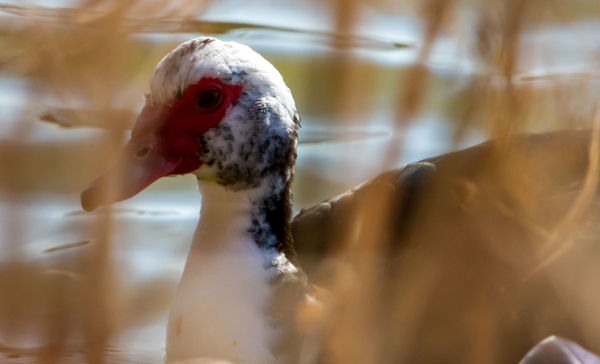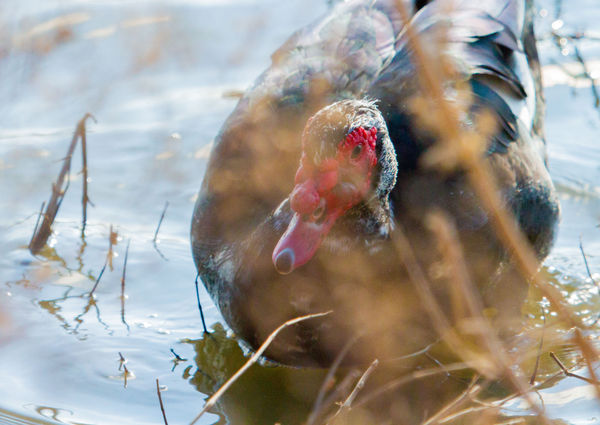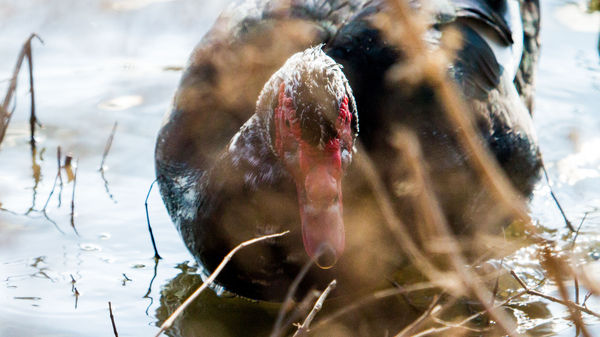Wildlife flop with Canon 100-400
Jan 5, 2013 22:50:18 #
Sigh. I tried to practice wildlife with a new lens, the Canon 100-400L IS USM using a Canon 7D. I know I have a LOT to learn, but my shots today were AWFUL. Below are the best of the lot,...with PP!! They were dark, grainy unfocused,... it was AWFUL. No, I didn't use a tripod, but I thought it was possible to capture wildlife with this lens hand held like with the 70-200 2.8. I did have a filter on...B+W premium digital MRC nano.
I'm studying Brian Petersons understanding exposure now. Is there something else that would be useful to figure out what shutter speed, aperature, ISO to use? I've see where they say still animals should be shot in AV, BIF in TV. Is that true? Help!
I'm studying Brian Petersons understanding exposure now. Is there something else that would be useful to figure out what shutter speed, aperature, ISO to use? I've see where they say still animals should be shot in AV, BIF in TV. Is that true? Help!



Jan 5, 2013 23:08:42 #
I think the biggest problem is that the brown grass was obscuring your ability to focus on the birds. You needed a clearer shot at them and I think they would have been fine.
What were your settings and ISO?
What were your settings and ISO?
Jan 5, 2013 23:14:47 #
Wendy2 wrote:
I think the biggest problem is that the brown grass was obscuring your ability to focus on the birds. You needed a clearer shot at them and I think they would have been fine.
What were your settings and ISO?
What were your settings and ISO?
The ISO was1250, the shutter was 1/4000, at F7.1 and F5.6. I was floundering out there. I felt like I couldn't get anything to focus. Like I said, these were the best out of many which were pure-d-trash! But thanks for your kind words.
Jan 5, 2013 23:25:31 #
If it was bright out, you probably didn't need such a high ISO. I believe the shutter speed was too fast. That is probably why your shots were dark and why they are grainy. When you take a dark photo and lighten that much, you are definitely going to get noise. Also, try smaller F stops too, such as 16. You will get more depth of field, more in focus. Did you get any clear shots of any of the birds, or was the grass always in the way?
Give it another try! You will get it with lots of experimenting and practice.
Give it another try! You will get it with lots of experimenting and practice.
Jan 5, 2013 23:31:00 #
Wendy2 wrote:
If it was bright out, you probably didn't need suc... (show quote)
Thank you! The clear shots I got were from behind and unfocused. I'll try the techniques you recommended. This lens was a bit more work for me, the push-pull takes getting used to. I won't give up! :-) Thanks!!! Dee
Jan 5, 2013 23:36:48 #
dellenthompson wrote:
quote=Wendy2 If it was bright out, you probably d... (show quote)
Great! Let's see more when you get some that you like, or don't like, for that matter. You will probably learn more when you show your bad shots because everyone here likes to help!
Jan 5, 2013 23:39:14 #
Wendy2 wrote:
quote=dellenthompson quote=Wendy2 If it was brig... (show quote)
Will do! It's a bit intimidating showing pics, but I figure, ...if I don't get feedback, I'll never improve! :-)
Jan 5, 2013 23:40:27 #
I don't do much wildlife stuff, but one thing I see is that these appear to be backlit. That being the case,you would need to increase your exposure to expose for the side toward you. How much? I don't know, but at least one stop, I would think. The bright light off the water is affecting your metering.
Jan 5, 2013 23:43:52 #
CaptainC wrote:
I don't do much wildlife stuff, but one thing I see is that these appear to be backlit. That being the case,you would need to increase your exposure to expose for the side toward you. How much? I don't know, but at least one stop, I would think. The bright light off the water is affecting your metering.
Yes!!! And I just didn't know what to do! This helps!!! Thank you!! Dee
Jan 5, 2013 23:52:39 #
You are all messed up. Lol. I do not believe there in a rule of thumb like that. I will shoot BIF many different ways depending on what I am after. I will even shoot in shutter priority. Some of my best shots of BIF were in aperture priority (AV). So it all depends. Lighting does have a lot to do with it.
These shots here could have been shot at ISO 100. The problem being what Wendy said; the grasses were in the way.
Shooting a BIF hand held is a trick with a 400mm lens and I am very young with a steady hand. But I will tell you what. I can do a better job shooting a BIF hand held using a 400mm than if I were to shoot a deer standing still hand held.
Think about it. When you are tracking a bird in flight and you are locked in on it, you are moving with the bird. If you are in focus, you should be able to take a good shot. If you are just standing there shooting at a still object, that is hell of a fulcrum you have there and it is very difficult to steady the camera well enough for a good shot. Hence, the use of a tripod or some sort of steady rest comes in handy. It just takes practice and understanding exposure.
These shots here could have been shot at ISO 100. The problem being what Wendy said; the grasses were in the way.
Shooting a BIF hand held is a trick with a 400mm lens and I am very young with a steady hand. But I will tell you what. I can do a better job shooting a BIF hand held using a 400mm than if I were to shoot a deer standing still hand held.
Think about it. When you are tracking a bird in flight and you are locked in on it, you are moving with the bird. If you are in focus, you should be able to take a good shot. If you are just standing there shooting at a still object, that is hell of a fulcrum you have there and it is very difficult to steady the camera well enough for a good shot. Hence, the use of a tripod or some sort of steady rest comes in handy. It just takes practice and understanding exposure.
Jan 5, 2013 23:58:02 #
tainkc wrote:
You are all messed up. Lol. I do not believe the... (show quote)
LOL! Okay,...I'll stop believing everything I read on the Internet, and will learn the principles of exposure! :-) And you are RIGHT about panning hand held and shooting. It's easier than holding still and taking a still shot. I'm a bit...er...more mature than you...(but young at heart) and I feel I need to do curls with my lens to build up my biceps so I can hold the camera steady when I shoot. LOL!!! It'll get better, I promise! Thanks! Dee
Jan 6, 2013 00:17:41 #
dellenthompson wrote:
Good. Keep up the curls. Lol. quote=tainkc You are all messed up. Lol. I do n... (show quote)
Jan 6, 2013 04:11:11 #
dellenthompson wrote:
They were dark, grainy unfocused,... it was AWFUL.
Dark? As in "underexposed?"
Well, that's easily fixed.
Quote:
No, I didn't use a tripod, but I thought it was possible to capture wildlife with this lens hand held like with the 70-200 2.8. I did have a filter on...B+W premium digital MRC nano.
No, I didn't use a tripod, but I thought it was possible to capture wildlife with this lens hand held like with the 70-200 2.8. I did have a filter on...B+W premium digital MRC nano.
If I were testing a lens I wouldn't have a filter on it...I'd want to be sure that the quality I was getting was the lens and not some semi-cheap piece of glass or plastic. (that's a good filter by the way)
Quote:
I'm studying Brian Petersons understanding exposure now. Is there something else that would be useful to figure out what shutter speed, aperature, ISO to use? I've see where they say still animals should be shot in AV, BIF in TV. Is that true? Help!
I'm studying Brian Petersons understanding exposure now. Is there something else that would be useful to figure out what shutter speed, aperature, ISO to use? I've see where they say still animals should be shot in AV, BIF in TV. Is that true? Help!
Good!
That's a great book.
Shutter, aperture and ISO are all subjective, they are what you set AFTER you determine what exposure you are looking for and what "creatively correct" exposure you want to execute.
You said you used the following settings:
The ISO was 1250, the shutter was 1/4000, at F7.1 and F5.6.
That shutter speed is plenty fast for birds who are not flying and your aperture is a "shortish/middle of the road" aperture...no problems there. The ISO is slightly high; not sure how your camera reacts to that high an ISO.
If it were me, I'd do the following:
1.) Remove the filter during testing at least.
2.) Use a lower ISO like 400-800 or less if I could get away with it.
3.) Remember that your camera's meter will be fooled in many circumstances and backlit water reflecting birds is one of them...sorry to say but that's a fact of life when using a camera's meter...that's why shots came out dark...the water or the brightest part of the sky was correctly exposed but your subject wasn't.
What shots you posted aren't bad at all...are they cropped a lot?
If they are; then that also brings up another point....filling the frame.
You cannot do miracles with any lens....if your subject is like a small bug in the huge frame, then the quality will suffer no matter how good your lens is...trust me. FILL THE FRAME with the subject! :)
Those steps should help a LOT....keep shooting and posting and let us know how it goes.
Jan 6, 2013 04:42:24 #
washy
Loc: Dorset UK
with a new lens why not set the camera to auto and see what that looked like and if was a reasonable sunny day start at 100 iso with white balance set at daylight. then check the histogram and the image on the camera. Then you could experiement from there.
Jan 6, 2013 04:53:42 #
washy
Loc: Dorset UK
if you managed to take pics with that you were happy with your other lens then it would be no different with the canon 400 you would just be nearer the subject. If you cannot hold the camera and lens and do not like tripods, best use a monopod . A monopod can be used as a walking stick to help up/down steep slopes and muddy/stony tracks but it also help to keep camera/lens steady and easy to pan with as well and not expensive. In your pics shown the brown reeds are what the lens is focusing on which is making the subjects slightly out of focus. keep going
If you want to reply, then register here. Registration is free and your account is created instantly, so you can post right away.




